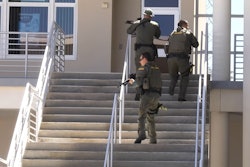Nearly every school in America is now well into its second year of being "open" and/or "back" and/or "normal" after the COVID-19 pandemic—and associated shutdowns—left those institutions of learning anywhere near any of those things.
For more than a year, students at every level of education were forced into an exile of sorts, removing them from their peers, their teachers, their activities, and certain elements of their child development.
Each individual has had—and will have—a different response to the vaguely vindictive mandates and the varying degrees of mismanagement and some will suffer no ill effects at all. However, others will inevitably have lasting negative consequences.
Only time will tell the totality of the damage done, but in the near term, anecdotal evidence—from teachers, school administrators, parents, mental health professionals, and others—suggests that in the immediate aftermath of the shutdowns, there is a substantial uptick in students expressing feelings of anxiety, depression, suicidal ideation, and tendency toward violence.
Shouldering (and Sharing) the Load
Of course, those bearing the brunt of this burden will be the students themselves, as well as parents, teachers, and administrators. However, post-pandemic life will also at times involve law enforcement, especially on campuses where there are School Resource Officers (SROs).
Each has to meet the new challenges, but SROs are in the unique position of not only having to deal with a new campus paradigm, but also—and most importantly—ensure the safety of everyone there.
Sergeant Mitch Brouillette of the Brentwood (CA) Police Department—who spent six years as an SRO at Heritage High School in the San Francisco Bay Area—says that the return to in-person learning and "normal" school life is multifaceted.
"Some kids out there took school for granted prior to COVID—the activities on campus, the football games, the social interaction—and during COVID I think they missed that," Brouillette says. "They missed a lot of the normal things—proms, homecomings, school activities, even some graduations. So I think the return to school for some kids was very needed and very, very wanted. Now they have like a new appreciation for going to school."
Brouillette says, however, that not everyone falls into that category. Some kids have slid substantially backward academically, socially, or behaviorally—some have struggled in all three categories.
"There's been a lot of negative that's come out of the post-COVID and return to school behavioral issues," Brouillette says. "Some of these kids moved up from elementary school to middle school, or middle school to high school, and now they're adjusting to a harder curriculum inside the classroom. What was required for them to do on Zoom was a lot less than what's required inside of a classroom."
Brouillette adds, "I think we're seeing a little bit more violence on campuses—fights and that kind of stuff. So for SROs, their new norm—if you want to call it that—is that it's gotten a little bit more difficult. But I think it's something that—over time—we can get back to what we were used to prior to COVID. I think it's just, it's an adjustment period."
During that period, Brouillette says that SROs will have to work closely with everyone else with some degree of investment in the school—from parents to teachers to the students themselves—but that the role of the SRO won't be fundamentally much different prior to the pandemic.
Brouillette says, "Even prior to COVID, I've said that the SRO's responsibility—his job, let's say—on that campus is really in the title. The SRO needs to be a resource—a school 'resource' officer. He needs to be a resource to the teachers, to the parents, to the students, to administration, and to his department.
Brouillette cautions that as much as they are a resource, SROs aren't there at the school to take over what are really the school's responsibilities.
"Tardiness, or dress code violations, school policies on cell phones," Brouillette says, "are school responsibilities."
Where SROs should be working to refine how they do their work in the post-COVID era, Brouillette says, is to focus on what just about everyone else in law enforcement has been focused on for the past two-plus years: de-escalation.
The Road from 2020 (in Hindsight)
Coronavirus was only one of the major roadblocks in the year 2020—and the two years hence—that completely altered the trajectory of law enforcement. Along that very bumpy road was the tragic in-custody death of George Floyd—2020 was also the year that de-escalation became "a thing."
Training in de-escalation techniques has permeated nearly every aspect of law enforcement, but when dealing with young people, there are a few layers of nuance not necessarily present in subjects under the influence of drugs or alcohol, emotionally disturbed persons (EDPs), or the violently mentally ill.
Young people of elementary school age have insufficient verbal communication skills to grasp even the simplest concepts when the brain is shut down by an emotional outburst. The "tantrum" may not be an immediate physical danger—although in some rare cases it certainly can be—but it is most definitely a challenge to manage for any adult, SROs included.
Adolescents, "tweens," and teenagers present the added problems of wildly out-of-control hormones, peer pressure, and perceived social status.
Brouillette says one of the best tactics for SROs to use in de-escalation is the removal of the "audience"—whenever it is possible to safely do so, deal with individuals individually.
"My very first thing when it comes to de-escalation is remove—if you can—the person from the crowd, or remove the crowd," Brouillette says. "You have to remove the audience. A student is going to act [out] at a way higher level if there's an audience than if you remove the audience."
Brouillette adds, "Once you're able to calm things down and talk in a lower tone of voice that's not threatening you [can say], 'Hey man, I know who you are, you know who I am. We've seen each other all these times on campus. I haven't seen you act like this before. What's really going on?' You can't have that conversation when there's a huge crowd because the person is experiencing a lot of things and they're hyped up. Once you are able to just get that person to take a quick little breath, then usually things kind of work out in your favor. The biggest thing is you've got to remove the crowd."
A Network of Interlocking Relationships
It's fair to say that education in America will never be what it was before the year that COVID hit. It's also fair to say that the student body bore the brunt of the damage.
Young people who had already been pretty well hooked on social media became almost compulsively addicted to the online world. Kids who were already prone to isolation, loneliness, depression, and suicidal ideation were thrust further into the deep dark corners of their own minds. Children who were socially awkward became socially inept.
Teachers had to figure out how to keep kids engaged via Zoom—some made it work, while others found work elsewhere. School board meetings started to take on a feel of a Thunderdome, and some parents made the difficult decision to homeschool their kids rather than allow their return to a system they disapproved of and disliked. Many SROs returned to regular patrol, some to never again return to a campus they once loved.
As everyone begins to adjust to whatever "new normal" will develop in coming years, it will require effort from students, parents, teachers, administrators, and most notable the SROs whose job it is to keep all of the above safe.
















